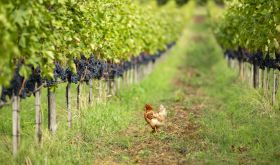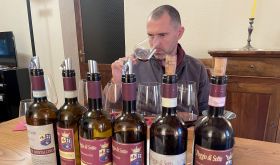In the three sets of recommended festive wines that preceded this one (festive fizz, merry reds and cool whites), I listed wines in ascending order of price, but I thought in this final collection of strong and/or sweet wines, it might be more appropriate to list them in ascending order of apparent sweetness, from a bone-dry, appetite-charging sherry to the positively tooth-rotting examples. Be assured that even the sweetest wines described below leave the palate refreshed thanks to their counterbalancing acidity or astringency. I have also given the alcohol level where I know it as this can be an important bit of intelligence. Note that many of these sweet wines come either in half bottles (37.5cl) or half-litres (50cl).
Every year now González Byass launches four top-quality dry sherries bottled straight from specially selected, very senior individual casks. My favourite of this year’s new releases is the third most expensive and venerable, González Byass, Tres Palmas Fino NV Sherry (about £40 per 50 cl Hedonism, Cambridge Wine Merchants, General Wine Co; 15.7%). Imagine liquid salted walnuts and you have some of the exciting pungency of this tangy, bone-dry wine that would be stunning with wafers of ham, nuts or hard cheese.
A slightly cheaper way to revive flagging appetites is González Byass, Del Duque VORS Amontillado NV Sherry (£20 per 37.5 cl Dickens House Emporium; 21.5%). Older and more substantial than the Tres Palmas, this has intriguing notes of both liquorice and peanuts before a clean, bracing finish. I suggest sipping it at key points between meals over the festive season. A bargain alternative is Morrisons Dry Oloroso NV Sherry (£6 per 37.5 cl Morrisons).
Another wine that would be great with nuts and cheese and is a bit too dry and delicate to drink with anything very sweet would be Henriques & Henriques 15 Year Old Bual NV Madeira (from £25 per 50 cl The Wine Society, Noel Young and many others; 20%). I loved its pungent evidence of long wood ageing on this extraordinary Atlantic island. This particular bottling was taken from cask in 2014 and is somewhere between medium dry and medium sweet. Usefully, it will last in an opened bottle forever.
Ports vary considerably in how sweet they taste. Graham’s, Single Harvest 1972 Port (£207 Hedonism, £216 Vintage Marque; 20%) is an extremely mature vintage-dated tawny that has notes of toffee and cut peel but is by now pretty transparent after more than 40 years in cask. It finishes rather dry and appetising. This uniquely historic wine was made in 1972 by Peter Symington soon after his family took over Graham’s but only bottled this year by his son Charles, who succeeded him as the Symington family’s head winemaker in 2009.
Blandy’s Terrantez 20 Year Old NV Madeira (£45 per 50 cl The Wine Society; 19%) may seem quite expensive but the Terrantez grape is exceptionally rare. Good for Chris Blandy for giving us all the chance to try this smoky, grippy rarity. It would be great with cheese.
Slightly sweeter is this long wood-aged offering from a co-op inland from Perpignan, Vignerons de Maury Solera 1928 Cask 768 NV Maury (Cask 835, presumably pretty similar, is £13.95 per 50cl from The Wine Society. Cask 932 is £19.95 from Berry Bros & Rudd; 17%). It tastes of almonds and orange peel and would go well with a not-too-sweet Christmas pudding.
Noble rot is the fungus that attacks grapes and turns the wine they produce into nectar. The area with the world’s greatest concentration of noble rot, or botrytis, is that surrounding the shallow Neusiedlersee in eastern Austria. A well-priced , sweet but delicate example from an exemplary winemaker based in the quintessentially mitteleuropean village of Rust is Heidi Schröck, Selektion Beerenauslese 2013 Burgenland (£25.20 per 37.5 cl Alpine Wines; 12.5%) based on the classic local blend of Welschriesling and Weissburgunder (Pinot Blanc).
A not terrifically sweet port, from a notably small harvest, that is at just the right stage to start enjoying is Warre’s, Quinta da Cavadinha 1998 Port (£30 RRP Waitrose, Vagabond Wines, Selfridges, Fenwicks; 20%). The fully mature nose has liquorice and dark chocolate notes with more bitter chocolate on the notably concentrated palate. Very vigorous with the tannins well in retreat, this should survive in a decanter for a few days rather than a few hours.
Vintage port is such a gorgeously satin-textured, polished sweet pleasure, but it has the exceptional disadvantage of demanding many, many decades in bottle before it really shows its potential. Quinta do Noval, Unfiltered Single Vineyard LBV 2009 Port (£15.99 Ocado, also Soho Wine Supply, General Wine Co; 19.5%)is, for once, an LBV (late bottled vintage) that does actually taste like an accelerated vintage port, or like a proper vintage-dated port from a single quinta. This does come from a single farm, the famous Noval, and has some of the intensity and spiciness of this estate’s famous vintage ports. This struck me as rather good value although there is no great hurry to drink it.
Fonseca 1966 Port (from £145 a bottle, Haslemere Cellar, The Vintage Port Shop and others; 20%). An example bottled by Berry Bros & Rudd tasted in October reminded me just how uniquely glorious fully mature vintage port can be.
Further proof is evinced by Graham’s 1983 Port (£59 Fingal-Rock, £64 Hard to Fine Wines, £100 Majestic; 20%], a fully evolved wine with beautiful round satin texture (all tannins fully dissolved) and a very winning combination of liquorice and haunting sweet red fruit. Very gorgeous. This is clearly a great vintage to enjoy now. And even Fonseca 1985 Port (£85 RRP Waitrose, Majestic; 20.5%) is just starting to drink well. Just a little bit spirity on the nose, this is wonderfully opulent and sweet on the palate with the tannins still making their presence felt. I would choose the ‘lesser’, or at least less ambitious, Fonseca Guimaraens 1998 Port (£28 RRP Booths, Fortnum & Mason, Haynes Hanson & Clark; 20%) as offering better value for current drinking. Amazingly, the 1985 still needs a bit of time.
If I were listing these wines in descending score order, this perfect wine would be at the very top. Ch d’Yquem 2001 Sauternes (about £220 per 37.5 cl The Sampler, Berry Bros & Rudd and many others; 13.5%). Of course it is relatively expensive so I am suggesting buying just a half bottle of it as a very special present – to yourself or wine-loving others. It airily combines tension and richness and, although already glorious, is likely to be going strong for decades.
I love the dry whites of the Greek island of Santorini but Argyros, Vinsanto 2007 Santorini (about £28 per 50 cl Bottle Apostle, Noel Young and others; 14%) proves just how stunning its sweet wines from dried grapes can be. This is extremely sweet with a flavour of orange peel but, like the best Tuscan vin santo, it is also miraculously refreshing.
Fontanel, Ambré 2001 Rivesaltes (£15.50 Stone, Vine & Sun; 16%) is the best-value wine in this collection and is, like the Maury above, delicious evidence of the wealth of mature and oft-forgotten vins doux naturels languishing in the cellars of Roussillon in the far south of France. Flavours available include dried apricots, butterscotch and nuts. Great stuff.
Most of us associate the name Harveys most readily with Bristol Cream, a sweet sherry that arguably got the noble wine of Andalusia a bad name. But now that Harveys have taken over the stocks of Domecq, they have access to some particularly ancient top-quality wines, some of which seem to have found their way into Harveys, Pedro Ximénez 30 Year Old VORS NV Sherry (£21.99 per 50 cl Waitrose and many others; 16%). Sun-dried PX grapes can yield liquids more like syrup of figs than an appetising wine but this is very sophisticated with an undertow of acidity and a little grip – not just sugar. Pour this over top-quality vanilla ice cream? It is certainly Christmas in a glass.













